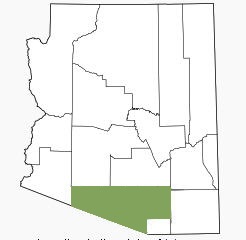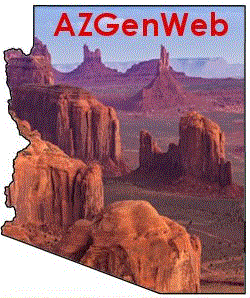Histories
- Biographies
- 1881 Arizona Business Directory
- 1891 Arizona History
- 1913 Who's Who in Arizona
- Places has county maps, place names, and brief histories of some Pima places
County History
Pima County was the one of four original Arizona Counties
created 10 Nov 1864 by the 1st Arizona Territorial Legislature.
"This Territory shall be divided into four counties, to be
bounded and named as hereinafter provided.
"First, the County of Pima, shall be bounded as follows: On the
east by 109th meridian of longitude, on the line of the
Territory of New Mexico, on the north by the middle of the main
branch of the Gila river, on the west by the line of 113 degrees
20 minutes west longitude, and on the south by the Sonora line.
The seat of justice whereof is hereby established at Tucson, and
the County Commissioners are hereby empowered to establish
precincts in said county.
"Second, the County of Yuma, ...
"Third, the County of Mohave, ...
"Fourth, the County of Yavapai, ...."
 Pima County lies at the northern range of the Sonoran Desert,
and is comprised of mountain ranges, river valleys, and cactus
forests. Recent archaeological digs along the Santa Cruz River
near Tucson suggest that this area is one of the oldest
continuously inhabited areas of the United States, with
irrigation canals that may be the oldest in North America.
Native Americans have continuously inhabited this region from
prehistoric times to the present. The Tohono O'odham reservation
in Pima County is the second largest reservation in the nation.
Pima County lies at the northern range of the Sonoran Desert,
and is comprised of mountain ranges, river valleys, and cactus
forests. Recent archaeological digs along the Santa Cruz River
near Tucson suggest that this area is one of the oldest
continuously inhabited areas of the United States, with
irrigation canals that may be the oldest in North America.
Native Americans have continuously inhabited this region from
prehistoric times to the present. The Tohono O'odham reservation
in Pima County is the second largest reservation in the nation.
The Spanish
Father Kino founded the Mission of San Xavier del Bac in 1697
and it is still in use today. It is considered by many to be the
most beautiful of all the Kino Missions.
In 1775, Juan Bautista de Anza and his colonizing expedition,
traveled northward along the Santa Cruz River on their way to
San Francisco. Along the way, they passed through a Tohono
O’odham settlement they called Tuquison.
Earlier that year, on August 20, 1775, the Spanish authorities
founded the Presidio of San Agustín del Tucson, on the banks of
the Santa Cruz River. The Royal Presidio de San Augustin del
Tucson was completed by 1781, and it remained the northern-most
outpost of Mexico until the arrival of American soldiers in
1856. From a population of 395 in 1820, Tucson has grown to be
the second largest city in Arizona. It has always served as the
Pima County seat and was the Arizona Territorial capital from
1867 to 1877. Tucson is home to the University of Arizona and
many historical, ecological, and cultural attractions.
The United States
Pima County, the second largest of the four original Arizona
counties, was created by the 1st Arizona Territorial Legislature
in 1864 with land acquired through the Gadsden Purchase from
Mexico in 1853; approximately all of southern Arizona was
acquired from Mexico by the Gadsden Purchase. European
settlement of the region goes back to the arrival in the 1690s
of the Spanish.
The original county consisted of all of Arizona Territory east
of latitude 113° 20' and south of the Gila River. Soon
thereafter, the counties of Cochise, Graham and Santa Cruz were
carved from the original Pima County.
About the middle of the 18th century, silver and gold were
discovered in the region and prospectors from Mexico entered the
area in droves. The latter part of the century saw expansion of
mining and ranching in Pima County and an increase in
population, despite the threat of attack from roaming bands of
Apaches.
Although greatly reduced from its original size, Pima County
still covers 9,184 square miles. It ranges in elevation from
1,200 feet to the 9,185-foot peak of Mount Lemmon. The San
Xavier, Pascua Yaqui and Tohono O'odham reservations together
account for ownership of 42.1 percent of county land. The state
of Arizona owns 14.9 percent; the U.S. Forest Service and Bureau
of Land Management, 12.1 percent; other public lands, 17.1
percent; and individual or corporate ownership, 13.8 percent.
Pima County has two Enterprise Zones, one in South Tucson and
portions of Tucson and the other in an unincorporated portion of
the county just southwest of Tucson.
For more information see the 17-page pdf file
Historic Summary of
Pima County



